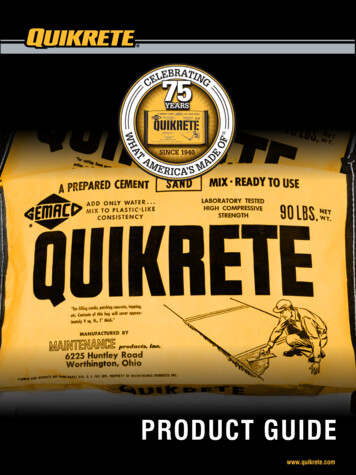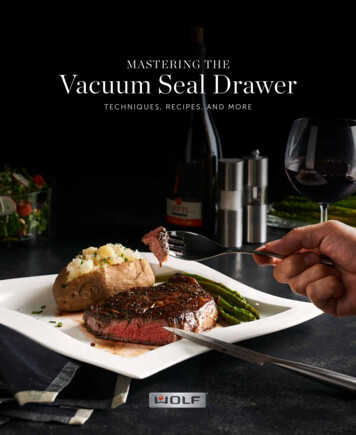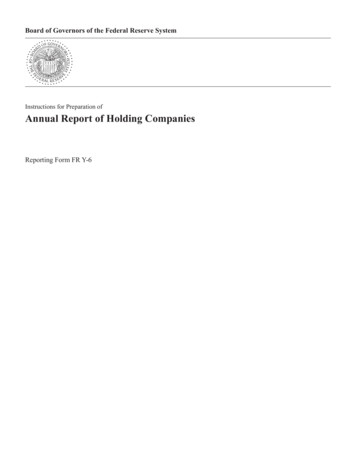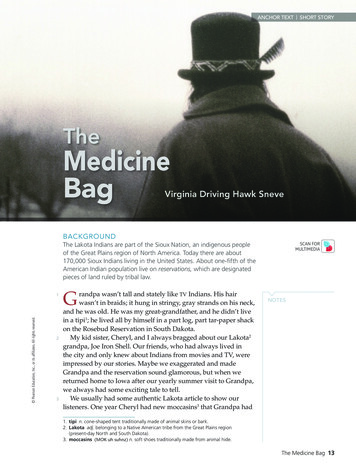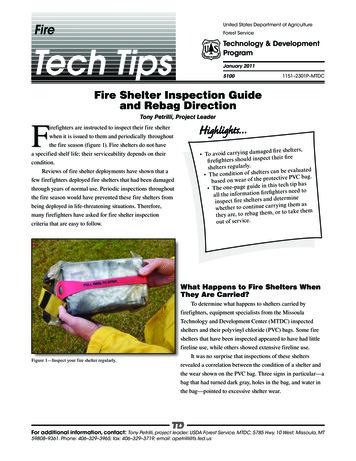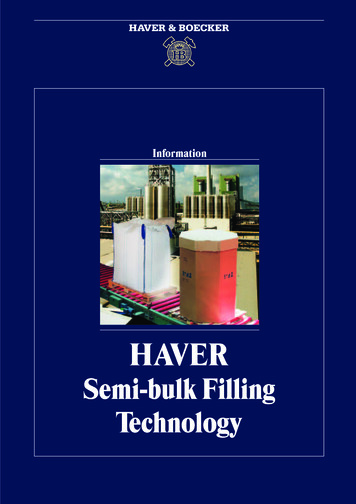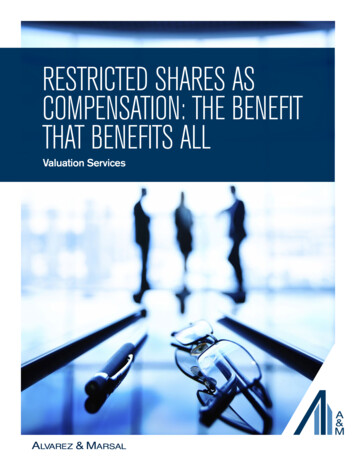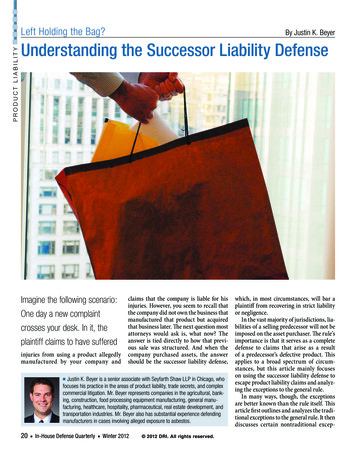
Transcription
Product LiabilityLeft Holding the Bag?By Justin K. BeyerUnderstanding the Successor Liability DefenseImagine the following scenario:One day a new complaintcrosses your desk. In it, theplaintiff claims to have sufferedinjuries from using a product allegedlymanufactured by your company andclaims that the company is liable for hisinjuries. However, you seem to recall thatthe company did not own the business thatmanufactured that product but acquiredthat business later. The next question mostattorneys would ask is, what now? Theanswer is tied directly to how that previous sale was structured. And when thecompany purchased assets, the answershould be the successor liability defense, Justin K. Beyer is a senior associate with Seyfarth Shaw LLP in Chicago, whofocuses his practice in the areas of product liability, trade secrets, and complexcommercial litigation. Mr. Beyer represents companies in the agricultural, banking, construction, food processing equipment manufacturing, general manufacturing, healthcare, hospitality, pharmaceutical, real estate development, andtransportation industries. Mr. Beyer also has substantial experience defendingmanufacturers in cases involving alleged exposure to asbestos.20 In-House Defense Quarterly Winter 2012 2012 DRI. All rights reserved.which, in most circumstances, will bar aplaintiff from recovering in strict liabilityor negligence.In the vast majority of jurisdictions, liabilities of a selling predecessor will not beimposed on the asset purchaser. The rule’simportance is that it serves as a completedefense to claims that arise as a resultof a predecessor’s defective product. Thisapplies to a broad spectrum of circumstances, but this article mainly focuseson using the successor liability defense toescape product liability claims and analyzing the exceptions to the general rule.In many ways, though, the exceptionsare better known than the rule itself. Thisarticle first outlines and analyzes the traditional exceptions to the general rule. It thendiscusses certain nontraditional excep-
tions that courts have crafted to addressproduct claims, examining which statesemploy the rule’s nontraditional exceptions and why those states that have considered these nontraditional exceptions havealmost universally rejected them.Successor Liability—Traditional ExceptionsAs mentioned above, throughout theUnited States, liabilities of a selling predecessor will not be imposed on the assetbuyer. As the Illinois Supreme Courtexplained in Vernon v. Schuster, 688 N.E.2d1172, 1175 (Ill. 1997), this general rule preventing liability for buyers “developed asa response to the need to protect bonafidepurchasers from unassumed liability andwas designed to maximize the fluidity ofcorporate assets.” While attorneys typicallyuse this defense in product liability actions,they have used it in actions involvingbreaches of contract, ERISA, Comprehensive Environment Response, Compensation, and Liability Act (CERCLA) matters,labor law violations, and security tradingcases, to name a few.While the traditional rule exists,a court always confirms that a successor corporation has impunity from liability by analyzing whether a successor’sasset purchase from the predecessor ismade outside the exceptions to the general rule. Those exceptions fall into twocategories: traditional and nontraditional.The vast majority of states only recognizefour traditional exceptions. For a plaintiff to defeat a defendant’s successor liability defense in a state only recognizingthe traditional exceptions, a plaintiff mustshow that the successor (1) expressly orimplicitly assumed the predecessor’s liabilities, referred to as the “assumption- of- liability” exception; (2) merged with thepredecessor, referred to as the “de factomerger” exception; (3) merely continuedthe predecessor’s business, referred to asthe “mere- continuation” exception; or(4) completed the transaction for fraudulent purposes, referred to as the “fraudulent transfer” exception. The nontraditionalexceptions consist of the “product- line”and “continuity- of- enterprise” exceptions.For the assumption- of- liability exception to apply and impose liability on a suc-cessor, a buyer must assume the seller’sliabilities. When an agreement is silent,a plaintiff generally cannot show that thesuccessor assumed the predecessor’s liabilities. And, when an agreement expresslydisclaims liability, liability assumptiondoes not occur. However, many courts stillwill permit a successor to assume certain When an agreement issilent, a plaintiff generallycannot show that thesuccessor assumed thepredecessor’s liabilities. liabilities, such as tax liabilities or ERISAcontribution liabilities, without negatingthe defense.Additionally, a number of courts haveheld that, when a successor agrees to purchase insurance on the predecessor’s behalf, the agreement does not constitute anassumption of liability. See, e.g., George v.Parke-Davis, 684 F. Supp. 249, 253–254 (E.D.Wash. 1988) (holding that evidence that thebuyer agreed to name the seller as an additional insured did not transfer the seller’sproduct liabilities to the buyer); Weaver v.Nash Int’l, Inc., 562 F. Supp. 860, 862 (S.D.Iowa 1983) (finding no assumption of liability for the buyer even though the buyer toname the seller as an additional insured); Inthe Matter of New York City Asbestos Litig.,15 A.D.3d 254, 257–258 (N.Y. App. Div.2005) (finding no assumption of liabilityeven though the successor agreed to provide product liability insurance for the predecessor’s pre- closing operations); Green v.Firestone Tire & Rubber Co., Inc., 460 N.E.2d895, 899 (Ill. App. Ct. 1984) (finding no assumption of liability when the agreementwas silent about which party assumed liability and the successor agreed to name thepredecessor as an additional insured).To defeat impunity from liability underthe de facto merger exception, a plaintiffmust establish (1) a continuity of manage-ment, personnel, physical location, assets,and business operations between the successor and predecessor corporations; (2) acontinuity of shareholders from the predecessor to the successor; (3) the predecessorceased its business operations, liquidated,and dissolved as soon as legally and practically possible; and (4) the successorassumed the predecessor’s liabilities andobligations ordinarily necessary for theuninterrupted continuation of the predecessor’s business.When a plaintiff seeks to defeat the successor liability defense by invoking themere- continuation exception, the plaintiffmust show that (1) no corporation existedbefore the asset purchase, (2) the officersand directors of the two corporationswere similar, and (3) stock was transferredbetween the predecessor and the successorcorporations as a result of the asset purchase. It is important to note, however, thatthe mere- continuation exception and thede facto merger exception are often treatedas a single exception, with courts decidingapplicability based on whether or not thetwo corporations have common shareholders. If not, then neither exception applies.See, e.g., Douglas v. Stamco, 363 F. App’x100, 102 (2d Cir. 2010); Berg Chilling Sys.v. Hull Corp., 435 F.3d 455, 464–65 (3d Cir.2005); Ruiz v. Blentech Corp., 89 F.3d 320,325 (7th Cir. 1996).Fraudulent transfer is the last traditionalexception that will defeat impunity fromassuming a predecessor’s liability. When aselling company uses fraudulent means toescape liability, the successor can later befound liable for the predecessor’s debts orliabilities. While not all states have established a test for what constitutes a fraudulent transfer, 43 states and the District ofColumbia have adopted the Uniform Fraudulent Transfer Act, which presents a list offactors that a court may consider to decideif this exception applies. See Uniform LawComm’s, Fraudulent Transfer Act, Enactment Status Map, http://www.nccusl.org/Act.aspx?title Fraudulent%20Transfer%20Act (accessed Nov. 9, 2011). For example, courtsconsider it fraudulent when a company sellsits assets to another company in which theseller’s shareholders hold a stake for far below market value. See, e.g., Welco Indus.,Inc. v. Applied Companies, 617 N.E.2d 1129,In-House Defense Quarterly Winter 2012 21
Product Liability1134 (Ohio 1993) (citing Turner v. Bituminous Cas. Co., 244 N.W.2d 873, 887 (Mich.1977)) (Coleman, J., dissenting).In those states that only recognize thetraditional exceptions, the successor liability defense is generally applicable as longas (1) the successor did not agree to assumethe liabilities of the predecessor, (2) there isdiscontinuity of shareholders, and (3) thesuccessor paid substantial and fair consideration for the assets. It is important tonote, however, that courts in certain stateshave found that a successor may still owean independent duty to warn about a predecessor’s defective product, meaning thatthe defense will not defeat a failure- to- warnclaim in that context. Those state courtsfinding that a successor owes such a dutydecide whether the successor breached thatduty using the postsale, duty-to-warn analysis offered in the Restatement (Third) ofTorts: Product Liability §10 (1998).Successor Liability—TheNontraditional ExceptionsFor decades, plaintiffs’ attorneys have triedto convince courts to expand the traditionalexceptions to shift liability to successorcorporations in the product liability andthe federal remedial statute context eventhough those successors did not harm theplaintiffs. The first decision of prominencein which a court expanded the traditionalexceptions occurred in Cyr v. B. Offen & Co.,501 F.2d 1145 (1st Cir. 1974), a decision inwhich the First Circuit, interpreting NewHampshire law, held that a court should notbe bound by the traditional exceptions andinstead should review the specific claims ofa lawsuit to determine if successor liabilitywas appropriate. The New Hampshire Supreme Court later rejected the Cyr interpretation of New Hampshire successor liabilitylaw in Simoneau v. South Bend Lathe, Inc.,543 A.2d 407 (N.H. 1988), and Bielagus v.EMRE of New Hampshire Corp., 826 A.2d559 (N.H. 2003).Three years after the Cyr decision, theMichigan Supreme Court created the“continuity- of- enterprise” exception, alsoknown as the “substantial continuity” exception, in Turner v. Bituminous Cas. Co.,244 N.W.2d 873 (Mich. 1976). In Turner, theMichigan Supreme Court held that a mergermay occur as a result of a cash transaction22 In-House Defense Quarterly purchase agreement would bind a successor corporation to a predecessor whenshareholders of each completely differed.In reaching this decision, the Turnercourt posited that successor corporationswere not structuring their asset- purchasedeals as such for the purpose of defeatinga plaintiff’s later strict liability claim, writing that “there is no basis for treating a pur chase of corporate assets different froma de facto merger. Both the injured partyState and federal courtsand the transferee corporation have common goals in each situation. It would makearound the country havebetter sense if the law had a common resultand allowed products liability recovery instruggled with whether they each case.” 244 N.W.2d at 880. The Turnercourt found that a successor’s acquisitionshould create new exceptions and use of a predecessor’s goodwill justified holding the successor liable for a prespecifically to addressdecessor’s manufacturing defects. Withthat rationale serving as its springboard,product liability law andthe Turner court held that, when a plaintiff presented evidence proving the followfederal remedial statutes.ing elements, the continuity- of- enterpriseexception would defeat the general rule establishing impunity from assuming theliability of a successor:(1) There is a continuation of the entercessor may be held liable for a predecessor’sprise of the seller corporation so thatdefective product if the successor contincontinuity of management, personued to manufacture the same product linenel, physical location, assets, andfrom which the defective product came andgeneral business operations exists;as long as the predecessor dissolved soon(2) The seller corporation ceases itsafter the asset sale.ordinary business operations, liqOver the past three-plus decades, stateuidates, and dissolves as soon asand federal courts around the country havelegally and practically possible; andstruggled with whether they should cre(3) The purchasing corporation assumesate new exceptions specifically to addressthose liabilities and obligations ofproduct liability law and federal remethe seller ordinarily necessary fordial statutes. The vast majority of thosethe uninterrupted continuation ofstates, however, have rejected expandingnormal business operations of thethe traditional exceptions. The followingseller corporation.sections discuss the Turner and Ray decisions and explain the reasons why state 244 N.W.2d at 879, 883 (citing McKee v.courts around the country have rejected Harris- Seybold Co., Div. of Harris- IntertypeCorp., 264 A.2d 98, 103–105 (N.J. Super. Ct.the nontraditional exceptions.1970), aff’d, 288 A.2d 585 (N.J. Super. Ct.Continuity-of-Enterprise Exception1972)). In essence, the new exception tookIn Turner, the Michigan Supreme Court form as the de facto merger test without theconsidered whether a court should treat a continuity- of- shareholders element.cash purchase of assets the same as a stockCourts in Alabama and Alaska explicpurchase when deciding if product liability itly adopted this exception. Andrews v. Johntransfers to a successor corporation. 244 E. Smith’s Sons Co., 369 So. 2d 781, 785–N.W.2d 873 (Mich. 1976). In holding that it 86 (Ala. 1979); Savage Arms, Inc. v. Westshould, the Turner court determined that, ern Auto Supply Co., 18 P.3d 49, 55 (Alaskaunder certain circumstances, an asset- 2001). Courts in Pennsylvania and Neweven without the two corporations havingthe same shareholders.In 1977, the California Supreme Courtin Ray v. Alad Corp., 560 P.2d 3 (Cal. 1977),rejected the continuity- of- enterprise exception, instead crafting a new exception,known as the “product- line” exception.Based on the product- line exception, a suc-Winter 2012
Jersey referred favorably to the exception,but both eventually adopted the product- line exception. See Dawejko v. JorgensenSteel Co., 434 A.2d 106, 111 (Pa. Super. Ct.1981); Ramirez v. Amsted Indus., Inc., 431A.2d 811, 818–819 (N.J. 1981). And Ohioand Mississippi courts signaled that theexception may apply in the context of aproduct liability lawsuit, but neither seemingly adopted the theory. Flaugher v. ConeAutomatic Mach. Co., 507 N.E.2d 331, 336(Ohio 1987) (suggesting that the theorymay be applicable but not expressly adopting because the case facts did not show continuation of the predecessor’s business tothe successor’s). But cf. Welco Indus., Inc. v.Applied Companies, 617 N.E.2d 1129, 1133(Ohio 1993) (rejecting the exception forcontract claims). See also Paradise Corp. v.Amerihost Dev., Inc., 848 So. 2d 177, 180–181 (Miss. 2003) (while signaling that itwas adopting the continuity- of- enterpriseexception, the opinion turned on questionsof fraud and unjust enrichment, throwing into doubt whether the state truly hasadopted this exception or merely foundthat a fraudulent transfer occurred).Additionally, when considering successor liability issues arising under federalremedial statutes such as CERCLA or theFair Labor Standards Act (FLSA), somefederal courts have used a test similar tothe continuity- of- enterprise test to analyze whether a successor could be foundliable. However, the recent trend appearsto be that federal courts apply state lawinterpretations of successor liability ratherthan craft separate, federal common law.See, e.g., United States v. Bestfoods, 524 U.S.51, 63 (1998).Other than these states, however,courts considering the continuity- of- enterprise exception have almost universally renounced it, with courts in 23 statesincluding Florida, Illinois, Maryland, NewYork, Virginia, and Wisconsin rejecting orcriticizing the exception. Courts criticizethe Turner decision because the decisiondisregards fundamental premises of product liability, contract, and corporate law.From the product liability standpoint,the Turner decision and its progeny ignorethat strict liability seeks to hold the actualmanufacturer of a defective productresponsible for manufacturing that prod-uct. The Minnesota Supreme Court summarized the arguments against applyingthis exception in Niccum v. Hydra ToolCorp., 438 N.W.2d 96, 99 (Minn. 1989).There, the Court wrote:Opponents of the expansion argue liability should not be imposed on a successor corporation because (1) thesuccessor corporation did not create therisk by placing the defective product intothe market; (2) any profit realized on theproduct is only received in a remote way;and (3) the successor has not representedto the public the safety of the predecessor’s product.Id.The Florida Supreme Court, echoing theNiccum Court’s sentiments, wrote:Extending liability to the corporate successor is not consistent with at least onemajor premise of strict liability, whichis to place responsibility for a defective product on the manufacturer whoplaced that product into commerce. Thecorporate successor has not created therisk, and only remotely benefits from theproduct. The successor has not invitedusage of the product or implied its safety.Since the successor was never in a position to eliminate the risk, a major purpose of strict liability in modifying amanufacturer’s behavior is also lost.Bernard v. Kee Mfg. Co., Inc., 409 So. 2d1047, 1050 (Fla. 1982).Other courts have criticized the Turnerdecision and, by extension, the continuity- of- enterprise exception, because the analytical foundation upon which Turner restsdisregards fundamental principles of contract and corporate law. Specifically, whilethe Turner court acknowledged that corporate parties “wish to know as exactlyas possible what they are buying and selling in order to establish an appropriateprice,” 244 N.W.2d at 878, a successor isrequired to bear the financial responsibility for unknown defects in a predecessor’s product, unknowable future injuriesto a predecessor’s customers, and the successor must bear such responsibility foran unforeseeable period of time. Ratherthan eliminating uncertainties betweencontracting corporations, the exceptioninstead creates potentially chaotic results.This specific criticism is best articulatedin Johnston v. Amsted Indus., Inc., 830 P.2d1141, 1146–47 (Colo. Ct. App. 1992):[W]e disagree with plaintiffs that theelimination of the requirement of continuity of shareholders to establish amerger is an “insignificant change” intraditional corporate law. To the contrary, rather than being a meaningless requirement in finding a de factomerger, it is probably the most important element.In a traditional merger, the shareholders of the predecessor become theshareholders of the successor. And, in amerger, the liability of the predecessorcorporation necessarily becomes that ofthe successor. This is so, in part, becauseit is the shareholders that ultimatelyenjoy the profits, if any. Therefore, theycannot move as a group to another corporation to enjoy the continuing profits of the same business earned beforemerger but escape all possible losses thataccumulated before the merger.On the other hand, in a sale of assetswith no continuity of shareholders, allthat has transferred is the business. Thepredecessor corporation is left behindwith liabilities and with “money inhand.” The imposition of liability inthese circumstances defeats the legitimate expectations of the parties heldduring negotiations.(internal citations omitted). See also Nguyenv. Johnson Mach. & Press Corp., 433 N.E.2d1104, 1110 (Ill. App. Ct. 1982) (“There is little logic and little justice in requiring thesuccessor to assume the liabilities of thepredecessor. The successor has paid a substantial price for the assets of the predecessor, and the law should not require thesuccessor to pay a greater price, especiallyafter the fact of sale when it is impossiblefor the successor to return to negotiationsto change the price. Left behind is the predecessor corporation with money in hand.It should meet whatever liabilities it hadwith the price it has exacted. Its shareholders should ultimately suffer the lossesfrom liabilities the corporation had, not theshareholders of the successor”).Instead of creating contractual certainty, the continuity- of- enterprise exception perpetuates uncertainty for successorsand unfairly shifts liability away from theIn-House Defense Quarterly Winter 2012 23
Product Liabilityactual tortfeasors to innocent parties.Based on that, the vast majority of statesconsidering this nontraditional exceptionhave rejected it.Justification for imposing strict liabilityupon a successor to a manufacturerunder the circumstances here presentedrests upon (1) the virtual destruction ofthe plaintiff’s remedies against the original manufacturer caused by the successor’s acquisition of the business, (2) thesuccessor’s ability to assume the origi-Product-Line ExceptionIn Ray, the California Supreme Court considered whether a successor, which was notresponsible for placing a defective productinto the stream of commerce, was strictlyliable for a predecessor’s defective productswhen the successor did not acquire the assets in a way that offended the traditionalexceptions. 560 P.2d 3 (Cal. 1977). The Raycourt held that “a party which acquires amanufacturing business and continues theoutput of its line of products assumesstrict tort liability for defects in units of thesame product line previously manufacturedand distributed by the entity from which thebusiness was acquired.” Ray, 560 P.2d at 11.There, the plaintiff was injured after falling off an allegedly defective ladder manufactured by the predecessor. The trialcourt held that the successor was not liable for such injuries, further holding thatit was not a successor under the traditionalexceptions. The California Supreme Courtreversed, finding that[t]he purpose of the rule of strict tort liability is to insure that the costs of injuries resulting from defective productsare borne by the manufacturers that putsuch products on the market rather thanby the injured persons who are powerless to protect themselves” and “that thecost of an injury and the loss of time orhealth may be an overwhelming misfortune to the person injured, and a needless one, for the risk of injury can beinsured by the manufacturer and distributed among the public as a cost ofdoing business.”Id., 560 P.3d at 8 (internal citations omitted). The Ray court continued its analysisof product liability law by stating that “theparamount policy to be promoted by therule is the protection of otherwise defenseless victims of manufacturing defects andthe spreading throughout society of the costof compensating them.” Id. (emphasis inoriginal).Having analyzed what it believed wasthe thrust of strict liability law, the Raycourt held:24 In-House Defense Quarterly Instead of creating contractualcertainty, the continuity- of- enterprise exceptionperpetuates uncertainty forsuccessors and unfairly shiftsliability away from the actualtortfeasors to innocent parties. nal manufacturer’s risk- spreading role,and (3) the fairness of requiring thesuccessor to assume a responsibilityfor defective products that was a burden necessarily attached to the originalmanufacturer’s good will being enjoyedby the successor in the continued operation of the business.560 P.3d at 9. Further justifying its conclusion, the Ray court wrote, “imposing thisliability upon successor manufacturers not only causes the one who takes the benefit to bear the burden but precludes anywindfall to the predecessor that might otherwise result from (1) the reflection of anabsence of such successor liability in anenhanced price paid by the successor forthe business assets and (2) the liquidationof the predecessor resulting in avoidanceof its responsibility for subsequent injuriesfrom its defective products.” 560 P.3d at 11.Four years later, in Ramirez v. AmstedIndus., Inc., 431 A.2d 811 (N.J. 1981), andin Dawejko v. Jorgensen Steel Co., 434 A.2d106 (Pa. Super. Ct. 1981), the New JerseySupreme Court and Pennsylvania Superior Court each adopted the product- lineexception. Since 1981, only two other juris-Winter 2012dictions have adopted the product- lineexception. See Martin v. Abbott Labs., 689P.2d 368, 388 (Wash. 1984); Garcia v. CoeMfg. Co., 933 P.2d 243, 249 (N.M. 1997).While not completely clear, Mississippimay have also adopted the product- lineexception, albeit in dicta, in a case in whichthe facts did not give rise to liability basedon the product- line exception. See Huff v.Shopsmith, Inc., 786 So. 2d 383, 388 (Miss.2001) (“even though we view the product line theory as a viable basis for recovery, the present situation does not meet thestandards utilized by other courts that haveadopted the theory”). But cf. Huff, 786 So.2d at 390 (J. Cobb, concurring) (“I concurwith the result in this case and with all ofthe majority opinion except for its adoption by dicta of the ‘product line’ theory Such a major expansion of our state’s product liability law should only be done wherewarranted by the facts and after due anddeliberate evaluation and discussion bythis Court”).Other than these states, however, courtsin 29 states including Florida, Illinois, Massachusetts, New York, Ohio, Texas, Virginia, and Wisconsin rejected applyingthe product- line exception. In rejectingthis exception, three particular argumentsproved persuasive: “(1) the exception isinconsistent with elementary product liability principles, and strict liability principles in particular, in that it results inan imposition of liability without a corresponding duty; (2) the exception threatens small successor businesses witheconomic annihilation because of the difficulty involved in obtaining insurancefor defects in a predecessor’s product; and(3) the exception is essentially a radicalchange in the principles of corporationlaw and, as such, should be left to legislative action.” DeLapp v. Xtraman, Inc., 417N.W.2d 219, 221 (Iowa 1987).The Texas Court of Appeals furtherexplained the incongruence of the product- line exception with principles of strict liability, writing:At bottom, the rationale for imposingtort liability under the ‘product line’ theory amounts to imposing upon the ‘successor corporation’ a legal duty that itcannot possibly perform to prevent thespecific injury it is called upon to redress
by money damages. Thus, the ‘duty’ soimposed is not the ‘duty’ normally associated with tort law—the duty to avoidconduct that poses an unreasonable riskof harm to others—but instead a ‘duty’to make whole one who has suffered aninjury, as an insurer is required more orless to do by its contract of insurance.Griggs v. Capitol Mach. Works, Inc., 690S.W.2d 287, 291–292 (Tex. App. 1985).Also rejecting this exception, the Massachusetts Supreme Court wrote, “[I]t isnot the purchase by the successor corporation that deprived the plaintiff of a remedy,but rather the demise of the predecessor.Furthermore, the plaintiff’s lack of a remedy against the original manufacturers isnot a justification for imposing liability onanother absent fraud and causation.” Guzman v. MRM/Elgin, 567 N.E.2d 929, 931(Mass. 1991). See also Johnston, 830 P.2d at1144 (“strict liability should not be imposedbecause: the successor corporation did notcreate the risk nor did it directly profit fromthe predecessor’s sale of the defective product; it did not solicit the use of the defective product nor make any representationsas to its safety; and it is not able to enhancethe safety of a product that is already onthe market”).Other courts have been persuaded notto adopt the product- line exception dueto the potentially devastating effects itwould have on small businesses if theywere held liable for injuries caused by predecessors’ defective products. In Fish v.Amsted Indus., Inc., 376 N.W.2d 820, 827–828 (Wis. 1985), the Wisconsin SupremeCourt wrote that[s]mall manufacturers have a difficultproblem obtaining products liabilityinsurance and find it impossible to coverthe risks by raising prices because theyhave to compete with larger manufacturers who can keep the price down.Additionally, it is one thing to assumethat a manufacturer can acquire insurance against potential liability for itsown products and another to assume itcan acquire such insurance for the products made by a different manufacturer.Citing Nguyen, 433 N.E.2d at 1111. See alsoSemenetz v. Sherling & Walden, Inc., 851N.E.2d 1170, 1173–1174 (N.Y. 2006); Bernard, 409 So. 2d at 1049 (refusing to adoptthe product- line exception “due in part tothe threat of economic annihilation thatsmall businesses would face under such arule of expanded liability”).From the strict liability standpoint,these decisions highlight the major flaw inthe Ray decision, namely that (1) the successor did not create the defective product;(2) similar to the plaintiff, the successorlikely had no reason to suspect or knowthat the product was defective when itpurchased the assets; and (3) the successor likely did not know who the ultimateSuccessor Liability ❱ page svilleA tradition as a full-service law firm serving top corporations and emerging companies.Over 400 lawyers focusing on business transactions and litigation.OhioCincinnatiColumbusWest ChesterA commitment to continuing to invest in the communities in which we work.TennesseeNashvilleWest VirginiaCharlestonfrostbrowntodd.com201 North Illinois Street Suite 1900 Indianapolis 317.237.3800. Offices in Indiana, Kentucky, Ohio, Tennessee and West Virginia. THIS IS AN ADVERTISEMENT. 2011 Frost Brown Todd LLC. All rights reserved.In-House Defense Quarterly Winter 2012 25
Manag
For the assumption-of-liability excep - tion to apply and impose liability on a suc - cessor, a buyer must assume the seller's liabilities. When an agreement is silent, a plaintiff generally cannot show that the successor assumed the predecessor's lia-bilities. And, when an agreement expressly disclaims liability, liability assumption


